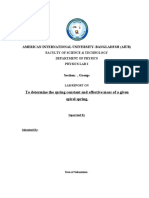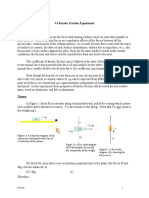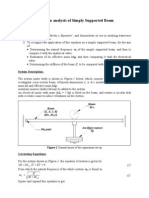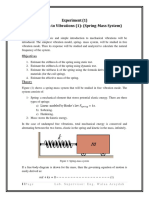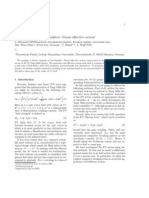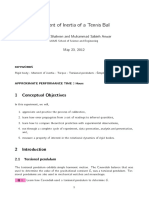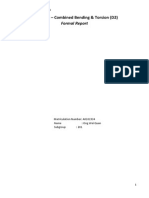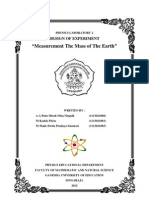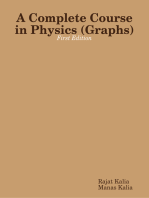Vibrations 7
Uploaded by
Egidius PutrandoVibrations 7
Uploaded by
Egidius PutrandoMech. Vibrations Lab. Manual, Expr.
#7
Dr. M. Dado, Eng. M. Shaban & F. Abu-Farha.
Mass-Spring System
I- Objectives:
1) To determine the stiffness of a helical spring using two methods; -Deflection curve and Hooks Law. -Time measurements. Then to compare their results with the analytical value. 2) To find the effective mass of the spring that has been used. 3) To evaluate the gravitational acceleration constant g. 4) To estimate the value of the modulus of rigidity G for the material of the helical spring, and compare it with the standard value for steel.
II- System Description:
The spring-mass system in Figure-7.1 shows an extension linear helical spring with an initial free length Li, effective mass mS, supported vertically from one of its ends; while the other end is free to elongate and attached to a load-carrier of (mC = 1.47 kg) mass. The free length of the spring loaded with the load carrier alone is Lo. Disks each of (md = 0.4 kg) mass are added to the carrier gradually, and each loading state causes the spring to elongate by the distance from its unloaded length Lo to get a total length of L.
Spring ms
Lo L
Disk md
Load-Carrier mc
Y
Figure-7.1 General layout of the experiment set-up
66
Mech. Vibrations Lab. Manual, Expr. #7
Dr. M. Dado, Eng. M. Shaban & F. Abu-Farha.
III- Governing Equations:
For the spring-mass system shown in Figure-7.1, in the case of free vibration in the vertical direction Y, the equation of motion of the system is given by:
+ Ky = 0 M y
(1)
where: M is the total mass of the system, and equals to:
M = m + mC + m S
m is the total mass of the disks
m = md
From the equation of motion, we can find that: * Natural frequency= n = * Period of oscillation= =
K M
(2) (3)
m + mC + m S 2 M = 2 = 2 n K K
For the linear spring following Hooks law, then:
FS = K
(4)
But for the present system, the spring force FS is also given by:
FS = mg
(5)
Combine eqns-4 & 5, to get:
m=
K g
(6)
For a helical spring, the stiffness is expressed analytically as:
K= Gd 4 8 ND 3
(7)
IV- Experimental Procedures:
67
Mech. Vibrations Lab. Manual, Expr. #7
Dr. M. Dado, Eng. M. Shaban & F. Abu-Farha.
1) Hang the spring vertically with the load carrier attached to its end, and then measure the total length of the spring Lo. (This length is not the initial free length of the spring Li) 2) Add one disk to the carrier (m = md), and measure the total length of the spring after elongation L. 3) With this loading, stretch the spring downward, then leave it to oscillate freely and record the time needed to complete ten oscillations T. 4) Add another disk so that (m = 2md), and repeat steps-2 & 3. 5) Continue by adding a disk each time for total ten disks (m = 10md), and each time measure the parameters L and T.
V- Collected Data:
Table-7.1 Data collected from the experiment execution
Trial 1 2 3 4 5 6 7 8 9 10
m (kg)
L (cm)
T (second)
Table-7.2 Dimensions and parameters of the spring
Parameter N (turns) D (mm) d (mm) Lo (cm)
Value
VI- Data Processing:
68
Mech. Vibrations Lab. Manual, Expr. #7
Dr. M. Dado, Eng. M. Shaban & F. Abu-Farha.
Square eqn-3, to get:
2 =
4 2 ( m + mC + mS ) K
Draw 2 versus m as shown in Figure-7.2.
1) Slope S1 =
4 2 K
K is determined. 2) Intercept with the vertical axis YInter =
4 2 ( mC + m S ) K
mS is determined. 3) Intercept with the horizontal axis X Inter = ( mC + mS ) mS is verified. From eqn-6:
m= K g
Draw m versus as the Slope S 2 = K g one shown in Figure K is also obtained. 7.3. You get the value:
S1 S 2 = 4 g
2
Multiply the slopes of the previous two steps. Use eqn-7:
K= Gd 8 ND 3
4
g is found, and compared to the standard value. Compare the two experimental values of K obtained before, with this theoretical value. Slope =
32 2 D 3 N , Gd 4
Find K directly.
Square eqn-3, and eliminate K using eqn-7, then:
32 2 D 3 N 2 = Gd 4 ( m + mC + m S )
Using Figure-7.2 of 2 versus m.
Determine G, and compare it with the standard value for steel.
VII- Results:
Table-7.3 Data processing analysis 69
Mech. Vibrations Lab. Manual, Expr. #7
Dr. M. Dado, Eng. M. Shaban & F. Abu-Farha.
Trial 1 2 3 4 5 6 7 8 9 10
m (kg)
(mm)
(second)
2 (second)2
Table-7.4 Data processing results
Spring Stiffness K K (theoretical) = (N/m) From: Slope K (N/m) Figure-3 Figure-4 Spring Effective Mass ms From Figure-7.2: YInter (kg.m/N) XInter (kg) ms (kg) ms (kg) Gravitational Acceleration g S1S2 (sec2/m) g (m/sec2)
Percent Error (% )
From Figures7.2 & 4
Percent Error (% )
From Figure-7.2
Modulus Of Rigidity G Slope (m/N) G (Gpa)
Percent Error (% )
VIII- Discussion And Conclusions:
70
Mech. Vibrations Lab. Manual, Expr. #7
Dr. M. Dado, Eng. M. Shaban & F. Abu-Farha.
1) What is the physical meaning of the Effective Mass of a spring? Is there an effective mass for Torsion springs?
2) Derive a formula for the effective mass of a linear helical spring ms in terms of its total mass Ms?
3) Use the dimensions of the spring to estimate its volume and total mass (by approximate calculations), and apply in the formula derived above to find its effective mass. Verify your experimental results.
4) In eqn-5
why didnt we equate the spring force FS with the total weight of the system Mg?
FS = mg ,
5) In determining the stiffness of the spring using the deflection curve of Figure7.3, what is the essential implicit assumption that has been made? How could you ensure that you did not violate it in the experiment using your graph?
71
You might also like
- Spring Constant Measurement - Static Dynamic Method50% (2)Spring Constant Measurement - Static Dynamic Method7 pages
- Torque and Equilibrium: Right Right LeftNo ratings yetTorque and Equilibrium: Right Right Left4 pages
- A Slider-Crank Experiment To Determine The Action of Static Forces100% (1)A Slider-Crank Experiment To Determine The Action of Static Forces10 pages
- Formulation of Stiffness Constant and Effective Mass For A Folded Beam PDFNo ratings yetFormulation of Stiffness Constant and Effective Mass For A Folded Beam PDF14 pages
- American International University-Bangladesh (Aiub)100% (2)American International University-Bangladesh (Aiub)9 pages
- James B. Anderson - Quantum Chemistry by Random Walk: Higher Accuracy For H +-3No ratings yetJames B. Anderson - Quantum Chemistry by Random Walk: Higher Accuracy For H +-35 pages
- # 6 Kinetic Friction Experiment DiscussionNo ratings yet# 6 Kinetic Friction Experiment Discussion4 pages
- American International University-Bangladesh (Aiub) : Faculty of Science & Technology Department of Physics Physics Lab 1No ratings yetAmerican International University-Bangladesh (Aiub) : Faculty of Science & Technology Department of Physics Physics Lab 110 pages
- Experimental Title: Bifilar and Trifilar SuspensionsNo ratings yetExperimental Title: Bifilar and Trifilar Suspensions34 pages
- Practice On Chapter (1) Q1: G12 Physics Physical Measurements and Dimensional Formula Notes Ch.No ratings yetPractice On Chapter (1) Q1: G12 Physics Physical Measurements and Dimensional Formula Notes Ch.5 pages
- Farabi - Dynamicstudyofat - Dynamicstudyofat 35413307No ratings yetFarabi - Dynamicstudyofat - Dynamicstudyofat 354133077 pages
- Method For Identification of Damping For A Cantilever BeamNo ratings yetMethod For Identification of Damping For A Cantilever Beam10 pages
- As Level Physics 2011 Smak Gs Kbi MeasurementNo ratings yetAs Level Physics 2011 Smak Gs Kbi Measurement13 pages
- L. Dittmann, T. Heinzl and A. Wipf - A Lattice Study of The Faddeev-Niemi e Ffective ActionNo ratings yetL. Dittmann, T. Heinzl and A. Wipf - A Lattice Study of The Faddeev-Niemi e Ffective Action3 pages
- Engineering Dynamics Static and Kinetic FrictionsNo ratings yetEngineering Dynamics Static and Kinetic Frictions13 pages
- Hysteretic Damping Modelling by Nonlinear Kelvin-Voigt ModelNo ratings yetHysteretic Damping Modelling by Nonlinear Kelvin-Voigt Model6 pages
- As Chapter 1 Physical Quantities and Units100% (2)As Chapter 1 Physical Quantities and Units50 pages
- The MODI and VAM Methods of Solving Transportation Problems: CD TutorialNo ratings yetThe MODI and VAM Methods of Solving Transportation Problems: CD Tutorial6 pages
- Coupled Spring Systems Using Matlab and GeoGebraNo ratings yetCoupled Spring Systems Using Matlab and GeoGebra7 pages
- Bisection Method: 1 The Intermediate Value TheoremNo ratings yetBisection Method: 1 The Intermediate Value Theorem3 pages
- Kinematic Analysis For Sliding Failure of Multi-Faced Rock SlopesNo ratings yetKinematic Analysis For Sliding Failure of Multi-Faced Rock Slopes11 pages
- Chute Performance and Design For Rapid Flow ConditionsNo ratings yetChute Performance and Design For Rapid Flow Conditions8 pages
- Algebra in Economics and Business: Foreign Trade UniversityNo ratings yetAlgebra in Economics and Business: Foreign Trade University16 pages
- Practice Exam 1 (Answers and Explanations)No ratings yetPractice Exam 1 (Answers and Explanations)35 pages
- Deflection of Beam (Civil Engg. For AUST EEE 1/1)100% (1)Deflection of Beam (Civil Engg. For AUST EEE 1/1)28 pages
- Formulas For The Calculation of Breakwaters: January 2001No ratings yetFormulas For The Calculation of Breakwaters: January 200121 pages
- Spring Constant Measurement - Static Dynamic MethodSpring Constant Measurement - Static Dynamic Method
- A Slider-Crank Experiment To Determine The Action of Static ForcesA Slider-Crank Experiment To Determine The Action of Static Forces
- Formulation of Stiffness Constant and Effective Mass For A Folded Beam PDFFormulation of Stiffness Constant and Effective Mass For A Folded Beam PDF
- American International University-Bangladesh (Aiub)American International University-Bangladesh (Aiub)
- James B. Anderson - Quantum Chemistry by Random Walk: Higher Accuracy For H +-3James B. Anderson - Quantum Chemistry by Random Walk: Higher Accuracy For H +-3
- American International University-Bangladesh (Aiub) : Faculty of Science & Technology Department of Physics Physics Lab 1American International University-Bangladesh (Aiub) : Faculty of Science & Technology Department of Physics Physics Lab 1
- Experimental Title: Bifilar and Trifilar SuspensionsExperimental Title: Bifilar and Trifilar Suspensions
- Practice On Chapter (1) Q1: G12 Physics Physical Measurements and Dimensional Formula Notes Ch.Practice On Chapter (1) Q1: G12 Physics Physical Measurements and Dimensional Formula Notes Ch.
- Farabi - Dynamicstudyofat - Dynamicstudyofat 35413307Farabi - Dynamicstudyofat - Dynamicstudyofat 35413307
- Method For Identification of Damping For A Cantilever BeamMethod For Identification of Damping For A Cantilever Beam
- L. Dittmann, T. Heinzl and A. Wipf - A Lattice Study of The Faddeev-Niemi e Ffective ActionL. Dittmann, T. Heinzl and A. Wipf - A Lattice Study of The Faddeev-Niemi e Ffective Action
- Hysteretic Damping Modelling by Nonlinear Kelvin-Voigt ModelHysteretic Damping Modelling by Nonlinear Kelvin-Voigt Model
- A Complete Course in Physics (Graphs) - First EditionFrom EverandA Complete Course in Physics (Graphs) - First Edition
- The MODI and VAM Methods of Solving Transportation Problems: CD TutorialThe MODI and VAM Methods of Solving Transportation Problems: CD Tutorial
- Bisection Method: 1 The Intermediate Value TheoremBisection Method: 1 The Intermediate Value Theorem
- Kinematic Analysis For Sliding Failure of Multi-Faced Rock SlopesKinematic Analysis For Sliding Failure of Multi-Faced Rock Slopes
- Chute Performance and Design For Rapid Flow ConditionsChute Performance and Design For Rapid Flow Conditions
- Algebra in Economics and Business: Foreign Trade UniversityAlgebra in Economics and Business: Foreign Trade University
- Formulas For The Calculation of Breakwaters: January 2001Formulas For The Calculation of Breakwaters: January 2001


















